Synthetic DNA and RNA Programming
A special issue of Genes (ISSN 2073-4425). This special issue belongs to the section "Molecular Genetics and Genomics".
Deadline for manuscript submissions: closed (15 September 2018) | Viewed by 67954
Special Issue Editors
2. Department of Biochemistry, University of Western Ontario, London, ON, Canada
Interests: epigenetics; genetic code expansion; molecular evolution; non-canonical amino acids; post-translational modifications; protein/RNA engineering; protein synthesis; sense codon recoding; redox biology; tRNA; mistranslation; neurodegeneration
Interests: RNA editing; molecular biology; protein biochemistry; RNA binding proteins; transcriptomics; RNA decay; synthetic biology
Special Issues, Collections and Topics in MDPI journals
Special Issue Information
Dear Colleagues,
Synthetic biology is a broad and emerging discipline that capitalizes on recent advances in molecular biology, genetics, protein and RNA engineering and omics technologies. These technologies have transformed our ability to reveal the biology of the cell and the molecular basis of disease. This Special Issue on “Synthetic RNA and DNA Programming” features original research articles and reviews, highlighting novel aspects of basic molecular biology and the molecular mechanisms of disease that were uncovered by the application and development of novel synthetic biology-driven approaches.
Dr. Patrick O'Donoghue and Dr. Ilka Heinemann
Guest Editors
Manuscript Submission Information
Manuscripts should be submitted online at www.mdpi.com by registering and logging in to this website. Once you are registered, click here to go to the submission form. Manuscripts can be submitted until the deadline. All submissions that pass pre-check are peer-reviewed. Accepted papers will be published continuously in the journal (as soon as accepted) and will be listed together on the special issue website. Research articles, review articles as well as short communications are invited. For planned papers, a title and short abstract (about 100 words) can be sent to the Editorial Office for announcement on this website.
Submitted manuscripts should not have been published previously, nor be under consideration for publication elsewhere (except conference proceedings papers). All manuscripts are thoroughly refereed through a single-blind peer-review process. A guide for authors and other relevant information for submission of manuscripts is available on the Instructions for Authors page. Genes is an international peer-reviewed open access monthly journal published by MDPI.
Please visit the Instructions for Authors page before submitting a manuscript. The Article Processing Charge (APC) for publication in this open access journal is 2600 CHF (Swiss Francs). Submitted papers should be well formatted and use good English. Authors may use MDPI's English editing service prior to publication or during author revisions.
Keywords
- genetic code expansion
- genome synthesis
- genome editing
- microRNA
- protein modification
- RNA metabolism
- tRNA
- synthetic biology
- unnatural amino acids
- unnatural nucleotides








